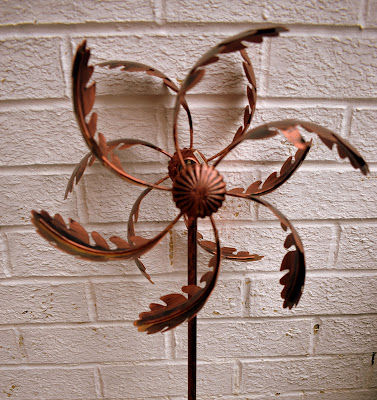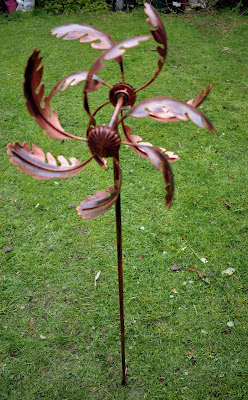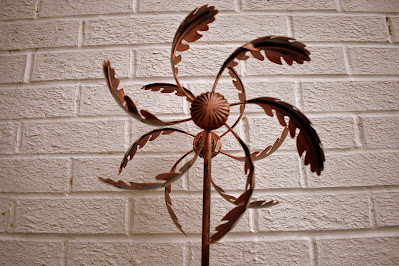There was always a Swiss Cheese Plant in our home when I was growing up. I did not know then that its Latin name is Monstera, but as a striking and larger than average house plant, it is certainly appropriate. As a child, I loved its jungle feel and the fact that it was bigger than me!
It is a beautiful and stunning indoor plant. In the 1970's it was a staple houseplant in many people's homes and was a background feature along with other plants.
Now it is again a very popular houseplant but it has taken more of a center stage being used as a real statement plant in a prominent position and even as a fashion trend.
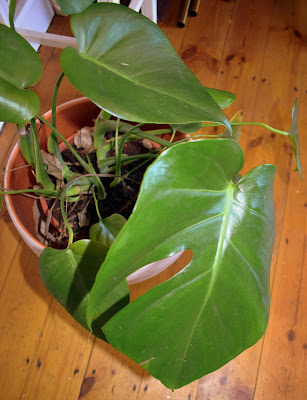
|
| Monstera Leaves and aerial roots. |
The Beauty Of A Swiss Cheese Plant
Grown as an indoor house plant this plant can grow to about 3 to 8 foot so it is a substantial house plant.
The leaves are pliable and very soft to touch and a pretty light or dark green glossy colour.
When the leaves are young they are of a solid heart shape. As they grow older the leaf develops splits in the leaf and this process gives it its name as it can look a little like swiss cheese.
It can grow large but we can also keep it at a manageable size to fit the space. Though if you can let it grow as large as it will it looks even more stunning.

|
| Mature Monstera Leaf With Split Against My Hand |
Native Growing Conditions Of The Monstera Or Swiss Cheese Plant
It is often useful and interesting to learn where the plants we have in our homes come from and what their native conditions are so we can better replicate them and keep them happy in our homes.
In native conditions in Central and South America, it grows under large trees in a jungle. In natural conditions, it can grow to up to seventy foot in height but it will not reach anywhere near this in a pot indoors. We can expect our plant to grow to approximately no bigger than eight foot if left to grow as big as it can.
Monstera does like to climb and has aerial roots which grow downwards from its main stem. As a houseplant, we can help it mimic its natural conditions by putting in strong support like a stake. As it can grow quite floppy and sprawling otherwise it can brace itself against the stake and do what it would in a jungle pushing itself onto a neighbouring tree or tangled vine for support as it grows upwards.
In its native conditions, this plant can flower a lovely white flower but it very rarely does as a houseplant. I have never seen a flower. So when you grow this plant indoors grow it for its beautiful glossy leaves of shades of green from light fresh green to mid and then dark green.

|
| Swiss Cheese Plant or Monstera |
Care of The Swiss Cheese Plant.
For such a big statement plant it requires remarkably little care. If you do not think you are good with houseplants then this is one that is hard to get wrong. I think it is one of the easiest plants I have.
It likes moist soil but never waterlogged, so regular consistent watering is best. As usual with house plants the best guide is the stick a finger about an inch into the soil if it is wet do not water but if dry or in this case nearly dry then water.
The soil should be water retentive but not too claggy so a good houseplant and compost mix on the neutral to acid side is best.
In its native situation it grows in the shade of large trees so do not place this plant in a sunny position. It needs a bright but shaded spot. It can cope with a few hours of the morning sun but absolutely no more than that.
As its large leaves can get dusty over time I like to take a cotton wool ball soaked in warm water and just gently wipe across the leaves. I only do this when they look dusty. This used to be one of my jobs when I was a child and I still enjoy doing it.
Monstera likes to be warm and loves humidity so an ideal situation is a heated bright bathroom where the light is filtered via blinds or obscured window panes and where the family take showers or baths.
Feed it regularly with Baby Bio or similar once a month and you will have a happy plant.
Swiss Cheese Plant Issues
It can have pests and diseases such as whitefly, mealybug, spider mites, powdery mildew to name a few but I have never had an issue and if you keep it in conditions it likes it will be healthy.
These infestations will rarely kill this plant anyway but look unsightly and weaken it so we have to control them and in this case I would use an insecticide or fungicide depending on the issue.
There are two things to watch for with the leaves. If you see a leaf or many leaves turning black then it is effectively that the plant has been sunburnt or scorched by being kept in a sunny place for too long.
The individual leaf cannot recover from this so the best thing is the prune away that leaf from the bottom of the stem. This will only happen if it has been exposed to too much direct sunlight so is easily avoided.
If you see the leaves turning yellow then we have overwatered. we must stop watering immediately, turn the pot and drain off any excess water and leave to dry. If very waterlogged we may be best repotting the plant into fresh dry soil and starting again with light watering.
While it likes moisture it hates sitting in wet soil so this can easily be avoided by only watering when the plant is nearly dry.
All parts of this plant are toxic to pets so it is best to keep it well away from them. Another reason a bathroom may be the best spot.
The plant featured here was one I bought as a sale plant a few months ago and I had to do a lot of pruning away of damaged leaves and sun scorched leaves. It was very large but uncared for. I have left one scorched leaf for you to see. This will need to be pruned away at the base. The plant was also unstable in its pot and rocking from its roots so I repotted in a new deeper pot so it is stable. My next job is to install firm support so it can climb.
I reduced the plant considerably in size but as you can see there is a lot of new growth and one leaf is already mature enough to have developed splits. So I was really happy I rescued this plant!
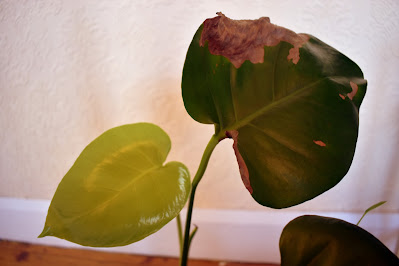
|
| Swiss Cheese Plant old sun damaged leaf next to new young leaf. |
Monstera In Fashion Trend
Who would have thought this plant would have become so fashionable. I tend not to grow plants indoors or outdoors for fashion trends but because I love them.
However, the trend is there for this plant to be used in wedding flowers, as centerpieces and large statement plants in prestigious offices.
People even cut a single stem with a large leaf on it and use it much as flower decoration in a vase of water, where it does look very striking.
It really suits an environment that is minimalist, clean and unfussy or where flowers would look too much. Its large size and dark glossy leaves do add understated style and substance.
There is even Monstera wallpaper which can look amazing as a real statement in the right place.
The Swiss Cheese Plant was so popular in the 1970's and then like many houseplants fell out of favour. However, now there is a thankfully increased appreciation of the beauty of houseplants and how good they are for us as well as looking beautiful and enhancing our home decor.
Fashion and trends come and go but I hope the love and appreciation for houseplants are here to stay now and I will never fall out of love with this amazing plant. It will grace our home with its simple stunning good looks for a very long time.






